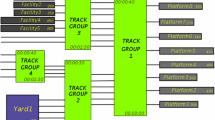Abstract
In this article, we address a variant of the rolling stock (RS) problem in dense railway systems within a metropolitan context. It consists in determining every train composition and scheduling empty trains to efficiently fit the demand. By empty trains we refer to scheduled trips where trains travel along the system without carrying passengers. A heuristic is presented to generate eligible slots for empty trains.Two objective functions are considered: minimizing the amount of RS and minimizing its usage (number of kilometres). An illustrative case study corresponding to the C5 line of a Spanish railway is presented.



Similar content being viewed by others
References
Alfieri, A., Groot, R., Kroon, L. and Schrijver, A. (2006) Efficient circulation of railway rolling stock. Transportation Science 40 (3): 378–391.
Cacchiani, V., Caprara, A. and Toth, P. (2010) Scheduling extra freight trains on railway networks. Transportation Research Part B: Methodological 44 (2): 215–231.
Cadarso, L. and Marín, A. (2011) Robust rolling stock in rapid transit networks. Computers & Operations Research 38 (8): 1131–1142.
Caprara, A., Monaci, M., Toth, P. and Guida, P.L. (2006) A Lagrangian heuristic algorithm for a real-world train timetabling problem. Discrete Applied Mathematics 154 (5): 738–753.
Cordone, R. and Redaelli, F. (2011) Optimizing the demand captured by a railway system with a regular timetable. Transportation Research Part B: Methodological 45 (2): 430–446.
CPLEX 11.1 Users Manual. (2006) ILOG CPLEX 11.1, ILOG, Inc., Incline Village, Nevada.
Eurostat. (2011) Goods Transport by Rail. 2.2.8-r1822-2012-04-02 (prod). Technical Report, Eurostat. Statistics.
Fioole, P.-J., Kroon, L., Marti, G. and Schrijver, A. (2006) A rolling stock circulation model for combining and splitting of passenger trains. European Journal of Operational Research 174 (2): 1281–1297.
Flier, H., Graffagnino, T. and Nunkesser, M. (2009) Scheduling additional trains on dense corridors. In: J. Vahrenhold, (ed). Experimental Algorithms, Springer Berlin Heidelberg, pp 149–160.
García-Sánchez, A., Ortega-Mier, M., Ibánez-Herrero, N. and Goti, A. (2011) A Mejora del tráfico ferroviario mediante programación lineal entera. DYNA Ingeniería e industria 86 (10): 585–593.
Renfe. (2010) Informe Anual, http://www.renfe.com/empresa/organizacion/memoria.html, accessed 6 March 2013.
Peeters, M. and Kroon, L. (2008) Circulation of railway rolling stock: A branch-and-price approach. Computers & Operations Research 35 (2): 538–556.
Schrijver, A. (1993) Minimum circulation of railway stock. CWI Quarterly 6: 205–217.
Author information
Authors and Affiliations
Corresponding author
Additional information
after one revision
This work partly stems from the participation of some of the authors in a research project funded by the Spanish Ministerio de Fomento, reference PT-2007-003-08CCPP, titled ‘Modelos de optimización aplicados a la planificación robusta y la gestión de los servicios metropolitanos de transporte público en caso de emergencia’.
Rights and permissions
About this article
Cite this article
Ibáñez-Herrero, N., García-Sánchez, Á., Ortega-Mier, M. et al. An extended rolling stock problem with empty trains timetabling through a heuristic approach. OR Insight 26, 220–233 (2013). https://doi.org/10.1057/ori.2013.4
Received:
Accepted:
Published:
Issue Date:
DOI: https://doi.org/10.1057/ori.2013.4




